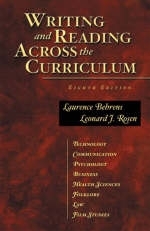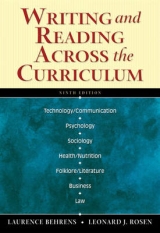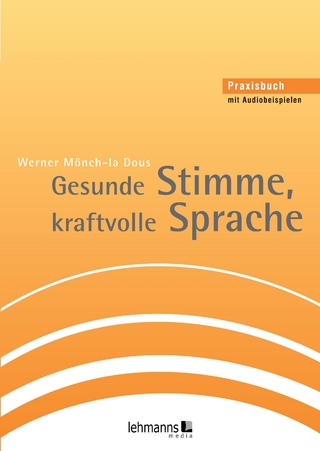
Writing and Reading Across the Curriculum
Pearson (Verlag)
978-0-321-09102-4 (ISBN)
- Titel erscheint in neuer Auflage
- Artikel merken
Hallmarks of the text include its sound writing instruction—focusing on summary, synthesis, and critique—combined with engaging, thematic readings that provide depth of coverage in each discipline-specific chapter. Expanded coverage of argumentation and writing online address issues of today's classrooms. Updated, streamlined pedagogy and class-tested new thematic chapters keep this classic exciting and current.
Preface.
Ancillaries.
A Note to the Student.
I. HOW TO WRITE SUMMARIES, CRITIQUES, AND SYNTHESIS.
1. Summary, Paraphrase, and Quotation.
What Is a Summary?
Can a Summary Be Objective?
Using the Summary.
How to Write Summaries.
Demonstration: Summary.
The Future of Love: Kiss Romance “Goodbye—It's Time for the Real Thing,” Barbara Graham.
Summarizing a Narrative or Personal Essay.
“Why I Will Never Have a Girlfriend,” Tristan Miller.
Summarizing Figures and Tables.
Paraphrase.
Quotations.
Incorporating Quotations Into Your Sentences.
Writing Exercise: Summary.
2. Critical Reading and Critique.
Critical Reading.
“A Simple One-Step Plan to Solve the Education Crisis,” J. Morton Davis.
Critique.
Demonstration: Critique.
Writing Exercise: Critique.
3. Introductions, Theses, and Conclusions.
Writing Introductions.
Writing a Thesis.
Writing Conclusions.
4. Explanatory Synthesis.
What Is a Synthesis?
Purpose.
Using Your Sources.
Types of Syntheses: Explanatory and Argument.
How to Write Syntheses.
The Explanatory Synthesis.
Demonstration: Explanatory Synthesis--Computers, Communication, and Relationships.
“Cyberspace: A New Frontier for Fighting Words,” Sanjiv N. Singh.
“Social Relationships in Electronic Forums: Hangouts, Salons, Workplaces and Communities,” Rob Kling.
Excerpt from Signs of Life in the USA, Sonia Maasik and Jack Solomon.
“Life At High-Tech U,” Deborah Branscum.
“Developing Personal and Emotional Relationships Via Computer-Mediated Communication,” Brittney G. Chenault.
Cyberspace Romances: Interview with Jean-Francois Perreault of "Branchez-vous," John Suler.
“Click Here for Romance,” Jennifer Wolcott.
“You've Got Romance! Seeking Love Online: Net-Based Services Change the Landscape, If Not the Odds, of Finding the Perfect Mate,” Bonnie Rothman Morris.
Consider Your Purpose.
Formulate a Thesis.
Decide How You Will Use Your Source Material.
Develop an Organizational Plan.
Summary Statements.
Write the Topic Sentences.
Write Your Synthesis.
Model Essay: “Advantages and Disadvantages of Computer-Mediated Communication,” Alyssa Mellott.
Discussion and Suggestions for Revision.
Revised Model Essay: “Computer Mediated Communication: New and Improved Human Relations or the End of Real Interaction?” Alyssa Mellott.
Writing Exercise: Explanatory Synthesis.
5. Argument Synthesis.
What Is an Argument Synthesis?
Demonstration: Developing an Argument Synthesis—The Wal-Mart Controversy.
“Ban the Bargains,” Bob Ortega.
“Eight Ways to Stop the Store,” Albert Norman.
“Wal-Mart's War on Main Street,” Sarah Anderson.
“Who's Really the Villain?” Jo-Ann Johnston.
Wal-Mart Stores, Inc. Hoover's Handbook of American Business.
“Victorious Secret,” Albert Norman.
“Shopping With the Enemy,” The Economist.
Developing and Organizing the Support for Your Arguments.
6. Research.
Going Beyond this Text.
Research Papers in the Academic Disciplines.
Finding a Subject.
The Research Question.
Preliminary Research.
Focused Research.
Book Review Digest.
From Research to Working Thesis.
The Working Bibliography.
Evaluating Sources.
Invention Strategies.
Arranging Your Notes: The Outline.
Writing the Draft.
Avoiding Plagiarism.
Citing Sources.
MLA Style.
APA Style.
Writing Exercise: Short Research Paper.
II.
An Anthology of Readings.
Technology/Communication.
7. Cyberspace and Identity: The E-Mail Revolution.
“We've Got Mail—Always,” Andrew Leonard.
“Going Postal,” Tony Schwartz.
“The A-List E-List,” David Brooks.
“Journey of an E-Mail,” John Dyson.
“Not Exactly the Most Reliable Way to Run a War,” Imho Roy Rivernburg.
“A Shared Sadness,” Russ Parsons.
“Virtual Love,” Meghan Daum.
“The Anonymous Voice,” Esther Dyson.
Cyberspace and Identity.
“Boy, You Fight Like a Girl,” Alex Pham.
“Faking it: The Virtual Lawyer,” Michael Lewis.
Synthesis Activities.
Research Activities.
Psychology.
8. Obedience to Authority.
“Group Minds,” Doris Lessing.
“Opinions and Social Pressure,” Solomon A. Asch.
“The Perils of Obedience,” Stanley Milgram.
“Review of Stanley Milgram's Experiments on Obedience,” Diana Baumrind.
“Obedience,” Ian Parker.
“The Stanford Prison Experiment,” Philip K. Zimbardo.
“Disobedience as a Psychological and Moral Problem,” Erich Fromm.
“The Organization Kid,” David Brooks.
Synthesis Activities.
Research Activities.
Business.
9. Business Ethics.
Opening Cases.
"The Sales Rep."
"The Research Director."
"The Marketing VP."
"The CEO."
"The Better Offer."
"The Faulty Hood Latch."
"Third-World Pharmaceuticals."
"Fashion Jeans."
"Hello—You're Fired."
"The Sick Day."
"The Double Expense Account."
Principles of Business Ethics.
"Thinking Ethics: The Rules of the Game," Robert C. Solomon.
"The Case of the Collapsed Mine," Richard T. De George.
"Ethical Decision Making in Business," Gerald F. Cavanagh.
Cases for Analysis and Discussion.
Case 1: "Peter Green's First Day," Laura L. Nash.
Case 2: "Romance on the Job," Thomas I. White and John R. Boatright.
Case 3: "Is Family-Friendly Always Fair?" John R. Boatright.
Case 4: "The Serpent Was There," Joseph Badaracco, Jr.
Case 5: "Is This the Right Time to Come Out?" Alistair D. Williamson.
Case 6: "Why Should My Conscience Bother Me?" Kermit Vandivier.
Synthesis Activities.
Research Activities.
Nutrition.
10. Weight(y) Matters: Being Overweight and Obese in America.
Jeffrey Koplan and William Dietz, "Caloric Imbalance and Public Health Policy."
Centers for Disease Control, "Prevalence of Obesity Among U.S. Adults, by Characteristics" and "Prevalence of Obesity Among U.S. Adults, by Region and State."
Wayt Gibbs, "Gaining on Fat."
Greg Crister, "Too Much of a Good Thing."
National Association to Advance Fat Acceptance, "NAAFA Policy on Dieting and the Diet Industry."
Mary Ray Worley, "Fat and Happy: In Defense of Fat Acceptance."
Roberta Seid. "Too `Close to the Bone:' The Historical Context for Women's Obsession with Slenderness."
Hillel Schwartz. "Fat and Happy?"
Eric Schlosser. "Why the Fries Taste So Good."
Atul Gawande. "The Man Who Couldn't Stop Eating."
Synthesis Activities.
Research Activities.
Folklore.
11. Fairy Tales: A Closer Look at “Cinderella.”
“Universality of the Folktale,” Stith Thompson.
“Cinderella,” Charles Perrault.
“Ashputtle,” Jakob and Wilhelm Grimm.
“When the Clock Strikes,” Tanith Lee.
“A Chinese
“The Maiden, the Frog, and the Chief's Son” (An African "Cinderella").
“Oochigeaskw—The Rough Faced Girl” (A Native American "Cinderella").
“Walt Disney's 'Cinderella,” Adapted by Campbell Grant.
“Cinderella,” Anne Sexton.
“On Location: Airy Fairy Tale,” Richard Covington.
“Conflicts,” Bruno Bettelheim.
“Pretty Woman: A Modern Cinderella,” Karol Kelley.
“Cinderella's Stepsisters,” Toni Morrison.
Synthesis Activities.
Research Activities.
Law.
12. You, the Jury.
The Maiden and the Pot of Gold: A Case of Emotional Distress.
“The American Legal System,” David Hricik.
“How to Present Your Case Systematically and Logically,” Veda R. Charrow, Myra K. Erhardt, and Robert P. Charrow.
“Venezia v. Miller Company: A Defective Beer Bottle?” Ruthi Erdman.
The Ridiculed Employee: An Additional Case of Emotional Distress.
Assault and Battery on the Gridiron: A Case of Reckless Disregard of Safety.
"Urban War Zone:" A Case of Public Nuisance.
The Felled Stop Signs: Some Cases of Homicide.
Drag Racing and Death: Some Cases of Manslaughter.
Legal Glossary.
Research Activities.
Legal Research.
Research Topics.
Film.
13. Good Take, Sweet Prince: Hamlet on Film.
“Shakespeare,” Sylvan Barnet.
“Hamlet as Tragedy,” Edward Hubler.
“Shakespeare and Nonverbal Expression,” Jack Jorgens.
Laurence Olivier's Hamlet.
“Cinematic Outline,” Jack Jorgens.
“An Essay in Hamlet,” Laurence Olivier.
“Review of Hamlet,” Margaret Marshall.
“Cinematic Outline,” Editors.
“Breaking the Classical Barrier,” (Interview) Franco Zeffirelli.
“Review: Monarch Notes,” David Denby.
Kenneth Branagh's Hamlet.
“Cinematic Outline,” Editors.
“Making Hamlet,” Kenneth Branagh.
“Review of Hamlet,” Roger Ebert.
“Rehearsing and Filming Hamlet: A Film Diary,” Russell Jackson.
“From Play to Screenplay: Aftermath of Murder,” William Shakespeare, Kenneth Branagh.
Michael Almereyda's Hamlet.
“Cinematic Outline,” Editors.
“The Rotten State of Denmark Corp,” Michael Almereyda.
“Review: The Prince is Dead, Long Live the Prince,” Alexandra Marshall.
Appendix: A Glossary of Film Terms.
Synthesis Activities.
Research Activities.
Credits.Index of Authors and Titles
| Erscheint lt. Verlag | 2.9.2002 |
|---|---|
| Sprache | englisch |
| Maße | 161 x 234 mm |
| Gewicht | 1123 g |
| Themenwelt | Geisteswissenschaften ► Sprach- / Literaturwissenschaft ► Sprachwissenschaft |
| ISBN-10 | 0-321-09102-7 / 0321091027 |
| ISBN-13 | 978-0-321-09102-4 / 9780321091024 |
| Zustand | Neuware |
| Haben Sie eine Frage zum Produkt? |
aus dem Bereich



